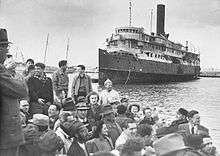Fourth Aliyah
The Fourth Aliyah (Hebrew: העלייה הרביעית, HaAliyah HaRevi'it) refers to the fourth wave of the Jewish immigration to Palestine, mainly from Europe, between the years 1924[1] and 1928.
| Part of a series on |
| Aliyah |
|---|
 |
| Jewish return to the Land of Israel |
| Concepts |
| Pre-Modern Aliyah |
| Aliyah in modern times |
| Absorption |
| Organizations |
| Related topics |
The character of the Fourth Aliyah
Starting around 1924 the character and the composition of the immigration to Palestine changed, and even though this immigration wave was very close to the previous immigration wave, it has been categorized as separate.
That wave brought rapid urban development, particularly in Tel Aviv, which absorbed a considerable amount of the immigrants. But during the years 1926 - 1927 an economic crisis occurred in the country, the toughest the Jewish settlement had during the period of the British Mandate of Palestine, and in spite of the economic comeback between the years 1928 - 1929, the crisis was identified with all of the period of the Fourth immigration. In the period of the crisis about 23,000 immigrants decided to leave the country.
In the fourth Aliyah about 80,000 immigrants[2] came to Palestine, mainly from the countries of eastern Europe, half of the immigrants from Poland and the rest from USSR, Romania and Lithuania. In addition to that 12% of all immigrants were from Asia, mainly Yemen and Iraq.
The causes for the immigration
Many of the new Jewish immigrants who arrived during this period, came as a result of increasing Anti-Semitism throughout Europe. The restrictive immigration quotas and laws of the United States kept Jews out. This group contained many middle class families that moved to the growing cities, establishing small businesses and light industry.